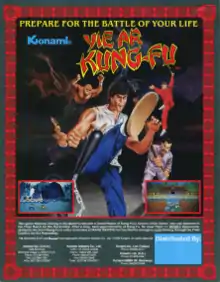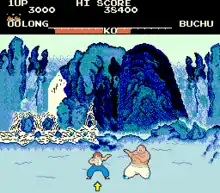Yie Ar Kung-Fu
Yie Ar Kung-Fu (イー・アル・カンフー, Ī Aru Kanfū) is a 1985 arcade fighting game developed and published by Konami. Along with 1984's Karate Champ, which influenced Yie-Ar Kung Fu, it is one of the games that established the basis for modern fighting games.[3]
| Yie Ar Kung-Fu | |
|---|---|
 Promotional sales flyer | |
| Developer(s) | Konami |
| Publisher(s) | Konami (arcade) Imagine (computers) |
| Composer(s) | Miki Higashino |
| Platform(s) | Arcade, Famicom/NES, MSX, Commodore 64, ZX Spectrum, Amstrad CPC, BBC Micro, Acorn Electron |
| Release | Arcade
|
| Genre(s) | Fighting |
| Mode(s) | One or two players (alternating turns) |
Gameplay

Yie Ar Kung-Fu (Chinese: 一二功夫; pinyin: yī èr gōngfū; lit. 'One Two Kung Fu') features a Bruce Lee-based Kung Fu master named Oolong (Chinese: 烏龍; pinyin: Wūlóng, Japanese: ウーロン Ūron; see oolong) (renamed Lee for the MSX and Famicom ports), controlled by the player. Oolong must fight all the martial arts masters given by the game (eleven in the arcade version; five to thirteen in the home ports) to win the title of "Grand Master" and honor the memory of his father. On his side is a variety of punch and kick blows reachable by combining the joystick with one of the buttons (punch or kick). He also has the greatest jumping ability of all the game's fighters, with the exception of "Blues".
The player faces a variety of opponents, each with a unique appearance and fighting style.[4][5] The player can perform up to 16 different moves,[6] using a combination of buttons and joystick movements while standing, crouching or jumping.[7] Moves are thrown at high, middle, and low levels. Regardless of the move that defeated them, male characters (save Feedle) always fall unconscious lying on their backs with their legs apart (players flail their feet), and female characters always fall lying on their sides. Feedle disappears. When a player gains an extra life, the word "xiè xiè" (Mandarin for "thank you") is heard.
On the arcade version, players can play on until all their lives are gone. No bonus lives are given thereafter once 9,999,900 is scored.
Characters
The 11 martial arts masters are listed below (in fight order): "Hot Fighting History":
- Buchu: Buchu uses a leaping motion to fly over Oolong, and as a middle level attack against him. Buchu may be big and powerful, but he's also slow. Much like Oolong, Buchu does not use weapons to fight. He is the first opponent in the first gauntlet and when he gets hit in the crotch, his eyes bug out and the game says "nǐ hǎo" (which is Mandarin for "hi" or "hello").
- Star: The first female opponent Oolong faces. Star is a young girl in a pink outfit who throws shuriken (that can be punched or kicked for extra points) at all levels, and uses fast punches and kicks, Star bears resemblance to Taiwanese martial arts-actress Angela Mao.
- Nuncha: Nuncha is a man in a yellow gi swinging nunchaku at Oolong at high and middle levels. His outfit and weapon are a homage to John Saxon's role as Roper in the movie Enter the Dragon.
- Pole: Pole is a short man who carries a large bo and uses it on Oolong. Pole also uses it to pole vault for extra momentum for his moves.
- Feedle: Feedle is basically an endurance test for Oolong. Numerous enemies (or the same enemy who can replicate himself) attack from both sides of Oolong, punching high and low. In some ports, like the Commodore 64 one, he/they are absent.
"Masterhand History":
- Chain: Chain awaits Oolong at the start of the second gauntlet (at the end of the first one in the Commodore 64 version). He is a large man who swings a giant chain with a claw-like attachment at the end (that can be punched or kicked at the extended end for extra points).
- Club: Club is another large man who attacks Oolong. Club swings a giant spiked club (chúi) and bears a shield on his right arm to block Oolong's attacks at middle level.
- Fan: Fan is another female warrior who wears a cheongsam and is more feminine than Star. Fan throws steel fans at Oolong like shuriken (that can be punched or kicked for extra points but only for a limited time before three at a time are thrown) and kicks very swiftly. The fans fall in a feather-like pattern.
- Sword: Sword is a dangerous warrior who comes ready to pounce on Oolong with a Dao and impressive aerial moves. Also capable of wrapping around to the other side of the screen.
- Tonfun: Tonfun is the final opponent Oolong must face before meeting his ultimate challenger, Blues. Tonfun attacks with two tonfa and fast-paced martial arts.
- Blues: Blues is almost a mirror image of Oolong without a shirt on and can match him move for move. Oolong has to find some weakness on Blues to win. (Blues can often defeat Oolong with a series of speed kicks to the body if trapped.) Since none of his clothes are blue, Blues is modeled after Bruce Lee with his name being another reference to the martial arts-actor, based on his first name's pronunciation when said by a Japanese speaker. When Blues is defeated, Oolong is the winner and the game begins again with Buchu (in the BBC Micro version, Blues is replaced by a second round with Feedle). Characters start to move more frequently and have more difficult attacks (e.g., Buchu flies more frequently, Star often throws three stars at a time, Nuncha starts jumping in response to Oolong's low kicks, Pole makes multiple hit attempts with the pole and not just one per charge motion at Oolong).
.png.webp)
The MSX and NES port has many differences from its arcade counterpart. The hero is called Lee and faces only 5 opponents:
- Wang: Armed with a pole. Unlike Pole, he doesn't use his pole to gain momentum.
- Tao: His special attack is breathing fireballs at the hero.
- Chen: This port's version of Chain. After Chen's defeat, there is a bonus round where the hero must hit objects thrown the 3 Shots at him to score points.
- Lang: This port's version of Star, but with quicker shots and moves.
- Wu/Mu: Called Wu in the MSX and Mu in the NES, he is similar to Buchu (though Mu is white and seems bearded, while Buchu is black and has a shaven face). While Once he is defeated, the challenge starts again with Wang.
There are two hidden characters in Konami Collector's Series: Arcade Advanced for the Game Boy Advance. To have access to them, the player must input the famous Konami Code at the title screen. The characters are available in the special two-player mode found on this collection. The fighters are Bishoo (a woman dressed in white who attacks with daggers) and Clayman (a living statue who attacks with a sword bigger than Sword's). A hidden character in the mobile phone version is Katana, a samurai who attacks with a katana but not as Shawn appears in MSX and NES Version.
Ports and related releases
Yie Ar Kung-Fu was subsequently widely ported to platforms including the MSX, Family Computer, Commodore 64, ZX Spectrum, Amstrad CPC and BBC Micro.
In 2002 it was included in the Konami Collector's Series: Arcade Advanced for Game Boy Advance.
An emulated version of the game was released in 2005 for PlayStation 2 in Japan as part of the Oretachi Geasen Zoku Sono-series.
It was released on Xbox Live Arcade for the Xbox 360 on July 18, 2007 with updated graphics[8] and for the Nintendo DS in Konami Classics Series: Arcade Hits.
In recent years, this game was re-released on some TV game products. In 1987, the game was included on the compilation Konami Coin-op Hits with Hyper Sports, Green Beret and Mikie.[9]
The NES version was relaunched for the Game Boy Color (as a part of Konami GB Collection Vol. 4), Sega Saturn and PlayStation.
The arcade version of Yie Ar Kung-Fu was made available on Microsoft's Game Room service for its Xbox 360 console and for Windows-based PCs in July 2010.
The MSX Version of Yie Ar Kung-Fu was released for D4 Enterprise's Project EGG service on October 28, 2014 in Japan.
Reception
| Publication | Score |
|---|---|
| Crash | 92% (ZX)[10] |
| CVG | 34/40 (BBC/C64/CPC/ZX)[11] |
| Sinclair User | |
| Your Sinclair | 8/10 (ZX)[13] |
| ACE |
| Publication | Award |
|---|---|
| Crash | Crash Smash |
In Japan, Game Machine listed Yie Ar Kung-Fu on their March 1, 1985 issue as being the second most-successful table arcade unit of the year.[15] The game was a commercial success in Europe. It went to number 2 on the UK sales charts, behind Capcom's Commando.[16] Yie Ar Kung Fu went on to become the second best-selling computer game of 1986 in the United Kingdom, at number-two on the overall 1986 chart.[17]
Sequel
A sequel, Yie Ar Kung-Fu II, was released a year later. The sequel was released only for home computers and was never ported to the arcades. Another fighting game by Konami, Martial Champion, was originally planned to be released as Yie Ar Kung-Fu 2. In fact, Jin, the protagonist of Martial Champion, was modeled after Lee, the protagonist of the NES and MSX versions, and after Ryu from the 1987 Street Fighter arcade game.
References
- http://www.arcade-history.com/?n=yie-ar-kung-fu-model-gx407&page=detail&id=3229
- http://www.worldofspectrum.org/showmag.cgi?mag=SinclairPrograms/Issue8508/Pages/SinclairPrograms850800011.jpg
- GameCenter CX - 1st Season, Episode 09. Retrieved on 2009-09-19
- Ryan Geddes & Daemon Hatfield (2007-12-10). "IGN's Top 10 Most Influential Games". IGN. Retrieved 2009-04-14.
- Hjul, Alison (March 1986). "Yie Ar Kung Fu" (3). Your Sinclair: 19. Cite journal requires
|journal=(help) - Game of The Week: Yie Ar Kung-Fu, GameSpy, accessed 2011-02-27
- Yie Ar Kung-Fu at the Killer List of Videogames
- Burg, Dustin (2007-07-16). "Yie Ar Kung Fu received a makeover | Joystiq". Xbox360fanboy.com. Archived from the original on 2008-09-30. Retrieved 2012-11-07.
- "Archive - Magazine viewer". World of Spectrum. Retrieved 2012-11-07.
- "Archive - Magazine viewer". World of Spectrum. Retrieved 2012-11-07.
- "Archive - Magazine viewer". World of Spectrum. Retrieved 2012-11-07.
- "Archive - Magazine viewer". World of Spectrum. Retrieved 2012-11-07.
- "Yie Ar Kung Fu". Ysrnry.co.uk. Retrieved 2012-11-07.
- "Archive - Magazine viewer". World of Spectrum. Retrieved 2012-11-07.
- "Game Machine's Best Hit Games 25 - テーブル型TVゲーム機 (Table Videos)". Game Machine (in Japanese). No. 255. Amusement Press, Inc. 1 March 1985. p. 21.
- http://ysrnry.co.uk/ys3.htm
- "Freeplay: Retro Computer Cabin", Computer and Video Games, no. 174, p. 118, May 1996
External links
- Yie Ar Kung-Fu at MobyGames
- Yie Ar Kung-Fu at SpectrumComputing.co.uk
- Article of Yie Ar Kung-Fu series at Hardcore Gaming 101